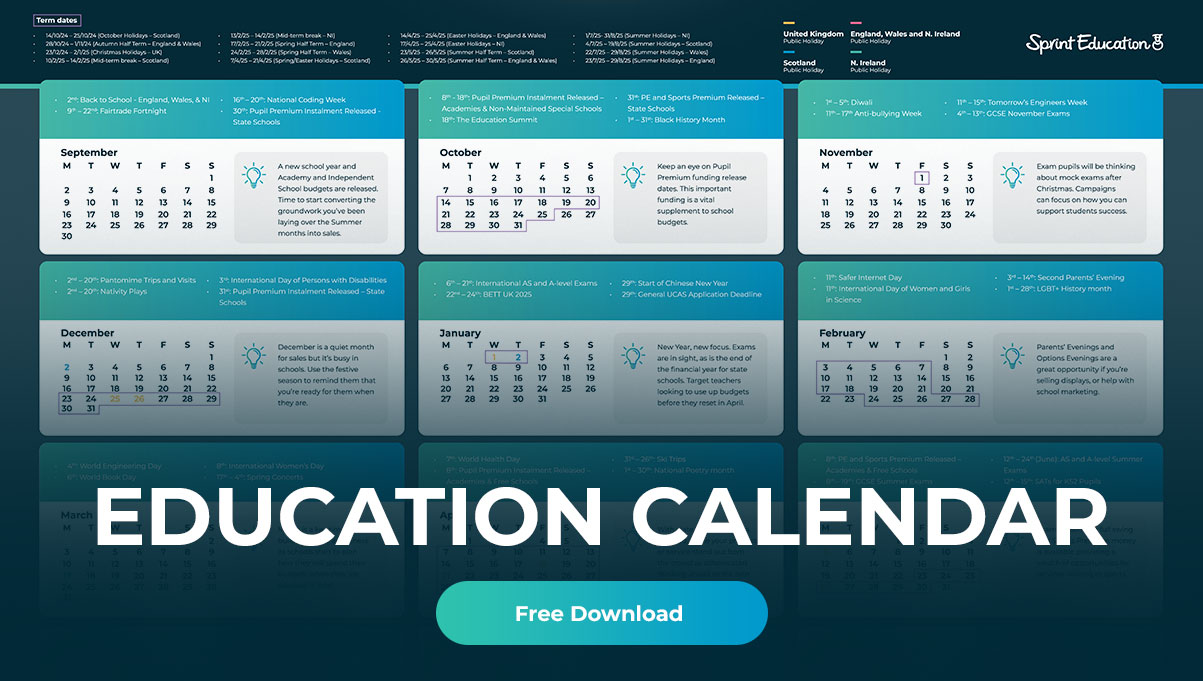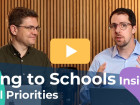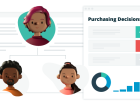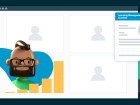7 Methods to Influence Schools' Purchasing Decisions
7 Methods to Influence Schools' Purchasing Decisions
Gain the insights you need to target the right decision-makers in schools and increase your sales.
Gain the insights you need to target the right decision-makers in schools and increase your sales.
When it comes to selling to schools, it’s important to know who you’re selling to. Not just the type of school, or the member of staff signing the cheque, but the teacher or leader channelling their inner Alan Sugar and deciding whether your product or service is up to their high standards.
When addressing the question ‘Who’s responsible for making purchasing decisions?’, it would be all too easy to answer with something glib, such as: “It all depends on what it is you’re trying to sell”, but essentially, this is what the decision all boils down to - albeit with that selling-to-schools spin.
Our blog ‘Turn Your Product into a Solution and Sell More to Schools’ is a great place to start in order to distil your strategy, and provide meaning to your product or service so that teachers have a clear picture of not just what you’re offering, but how it can benefit them.
But in today’s blog, we’re going a little more in-depth…
Practical or Pedagogical?
To first identify your target audience, you’ll need to work out which of the following two categories your product or service fits into, and the questions you need to ask yourself to get there.
Practical products relate to school infrastructure and its day-to-day running. Does your product or service improve building safety? Is your attendance monitoring system data relevant and easy to unpick? Do you have an effective recruitment programme that can plug teacher gaps?
These and dozens of other questions are to do with the many cogs in the school machinery that relate to the practical running of a school.
Pedagogical products are for what goes on in the classroom to promote great teaching and learning. Do you have a teaching resource that’s up-to-the-minute with the latest teaching curriculum? Does your software present a great way of monitoring student progress? Can you replace or upgrade dated classroom computer systems at a reasonable cost?
These questions scratch the surface of the many ways in which your business could help a teacher when preparing their lessons each day.
Now, you know which category your product or service fits in. So, you might be wondering what this might have to do with analysing who’s responsible for making the decision to purchase your product or service. The answer to that is ‘everything’.
I’ll tell you why, using our data to give you seven top tips on making sure you get your marketing to the right person, and make the sales you’re looking for.
1. Know your product’s place
Think about the two categories I’ve discussed above. Which one does your product fit into? Say you sell textbooks or some subject-specific software: those are pedagogical. Therefore, that’s going to be Heads of Department or Subject Leads. But read on - that’s not all there is to it.
It’s important to make the distinction between the two, as the role of Head of Department is one more likely found in secondary schools, whereas subject leads are more often a primary school role. (Having said that, working in a private Prep School for several years taught me that they often work in a similar way to their secondary counterparts with Heads of Departments overseeing curricular concerns for each subject area.)
A look at our State of Selling to Schools 2023 report shows that 46.8% of teachers say that the Head of Department is the staff member to go to when selling learning resources. Having said that, if your resource has the potential to be used school-wide, then it’s the Head Teacher (39.2%) or SMT (37.5%) that will be more likely to make that decision, according to respondents.
If a Multi-Academy Trust is looking to rebrand, or has a new sponsor, and needs to update its signage, you’re looking at a practical resource. 57.6% said the Head Teacher makes this sort of decision, with 35.5% saying to go to the Bursar or Business Manager, and 26% to SMT. The next-highest decision-makers are the Governors, who would definitely have some say in how the MAT would work towards a strong corporate image across its various schools.
2. Know your customer
This has just as much to do with when purchasing decisions are made, and my blog ‘Turn timing your Education Emails into an Artform’ gave two scenarios that could just as easily fall under this category of ‘knowing your customer’.
Campus users have the benefit of using our Insights Calendars to keep on top of key dates within a school year. This can really help to shape your sales strategy for targeting a specific event. For example, you could create a whole-school resource to promote International Women in Engineering Day that’s not only really engaging, but goes a long way in selling your awesome Design Technology software, and showing schools they can’t do without it!
It’s also worth bearing in mind that Heads of Departments and Subject Leads won’t necessarily be entirely responsible for selecting teaching resources. Class teachers are often right on the pulse of new innovations, and a well-run department will thrive on resource sharing and collaboration between teachers and other departments. In my last classroom role, as Head of Music in a big, busy department, I was always really grateful when the other teaching staff found new resources or even were just able to keep up with trends in what the students were listening to, and what we might be able to incorporate into our teaching.
So, if your resource can relate to a subject area or specific topic area, it’s a good place to start. And don’t forget that, often, a teacher or other staff member might have a particular passion or skill in a specific area: they could be keen eMentors with a passion for tech training, environmentalists who run an extracurricular eco-club… it could be pretty much anything! So, a clear subject line will help to direct your marketing to the right person if there’s no specific email address for that responsibility.
Primary schools work a little differently in this regard. A subject lead will take on similar responsibilities to that of a Head of Department, but they will be looking at how their subject is being taught across multiple year groups, such as all of Key Stage 1 or Key Stage 2, culminating in SATs tests if it’s a state school. Again, class teachers in that area will know their pupils really well, and select resources that suit them and their class, so targeting resources that enhance good teaching and learning in this group is a great starting point.
Lastly in this section, in the ‘Purchasing Decisions’ chapter of our report (Chapter 7, page 29), we asked educators when their biggest purchases were made, and when their contract renewals or subscription decisions happened. The most common answer by far was September, and even though that final decision might not actually be made until September, June came a fairly close second in both sets of results, and this neatly leads me to my next tip.
3. Build a relationship
Bigger purchases take more planning, and therefore more time. I was involved in putting together a suite of computers in one of the schools I taught at; this was a very complex purchase. For starters, we had our hands tied to some extent as the computer system we wanted to use didn’t quite align with what the IT department at that school preferred. Then we needed to get multiple quotes – it’s standard for bigger purchases to require at least three of them. This is where effective customer service came in – there were companies that responded in a fairly straightforward but not particularly engaging way. Others tried a bit too hard, so finding that sweet spot of being supportive but not pushy is a key balancing act when you’re trying to get teachers to choose you.
The computer suite was a large purchase, so it fell outside the realms of our departmental budget, and Senior Leadership needed to get involved. As teachers, we had to convince them of the value that our new Music Tech suite would be of benefit to our cohort of musicians, and what our development plan was going forward. Thankfully, we were well supported by the company we ended up going with for our purchase, all because they’d taken the time to build a relationship with us to support our needs.
4. Understand school’s priorities
Guess what? We’ve got a section on this in our State of Selling to Schools report! Let’s see what it says, and why it matters.
For the year 2023, teachers and leaders noted their top priority to be attainment and results. This isn’t really surprising after the huge disruption of the pandemic. This was a multiple-choice question in our survey, and over 70% chose this option. Second was emotional and mental wellbeing, with 52.3% of votes, and you can watch Lance and I discuss this topic in detail in the fourth of our ‘Insights’ videos.
What we can do now is match up those priorities to the category of resource, which will help you to know who to email to maximise your sales in one or more of these areas. Obviously, you’d be right to put ‘attainment and results’ under ‘pedagogy’ resources, but it’s not always quite as cut and dried as that. As an Assistant Head, I might be looking at attainment monitoring systems, so this would probably dip its toe into being a ‘practical’ resource, and you’d need to get a wider school buy-in to make the sale.
‘Facilities’ is lower on the list but is often in the news as school buildings start to age. This leads me to the next tip.
5. Keep up to date with the news
There’s always something you’ll need to pay attention to!
At Sprint, the Education Team (that’s me and Lance) give the other teams a roundup of what’s going on in schools news every fortnight, and it’s just as important for you to know the lie of the land when marketing to schools.
Whenever the results of funding bids are published, these appear in the news with comparisons with the previous year’s results. One example is the Condition Improvement Fund or ‘CIF’ where schools bid for help with often urgent repairs - a look at our Insights Calendar will tell you that these results are published in May each year. Buildings and facilities companies should know all about this funding and target their marketing accordingly.
It’s important to keep your finger on the pulse so that you can respond quickly should a news story potentially impact your campaign. And that leads me to my sixth tip.
6. Be flexible
We discuss the need for flexibility in our video on ‘Communicating with Schools’. This is where we again confirm that emails are the best way to communicate with teachers because it means they can respond at a time that suits them in amongst a hectic day of teaching.
Teachers are difficult to pin down. You might make an appointment to discuss your CDP programme with the Assistant Head of Pastoral at an Academy, only for it to be cancelled at the last minute because the Assistant Head was called out to deal with an urgent behaviour issue. This is why after school is often the best time to make these calls. Hang on though: the same Assistant Head has been called to speak with some parents about concerns over their child’s emotional wellbeing, so another opportunity to connect passes by.
Don’t worry though: by checking in via email (and on page 12 of our report you can see that 46.8% of teachers check theirs more than 10 times a day), you can build that relationship and the Assistant Head will be able to respond when they are ready, so it’s worth persevering and being flexible enough to work around their needs.
7. Keep an eye on the data
This is a simple last point. Read our report. Contact our team. Book a free Campus demo to explore the Insights module, the wealth of data, and everything else it can do that will help you to get your marketing to the right person.
What next?
So, as I said at the start, when it comes to who’s making the purchasing decisions, it does boil down to what it is you are selling. By using the tips above, you can ensure that your product or service gets to the right people and clearly shows them how it will benefit them and their students.
If you want to streamline your marketing and get it to the people that matter, explore the potential of Campus, our all-in-one education marketing and sales suite.
Campus wins you more business from schools by giving you access to all the education marketing data, intelligence, and built-in tools that are a must-have for any education business.
Build targeted contact lists, create winning emails, manage every aspect of your teacher sales funnel, and ultimately sell more to schools!
Click here to arrange your free demo, or contact us at info@sprint-education.co.uk or on 01684 297374.
Tags
Emailing Teachers
Selling to Schools
Education Marketing
Marketing to Schools
Marketing to Teachers
School Budgets
Selling to Teachers
Similar Articles
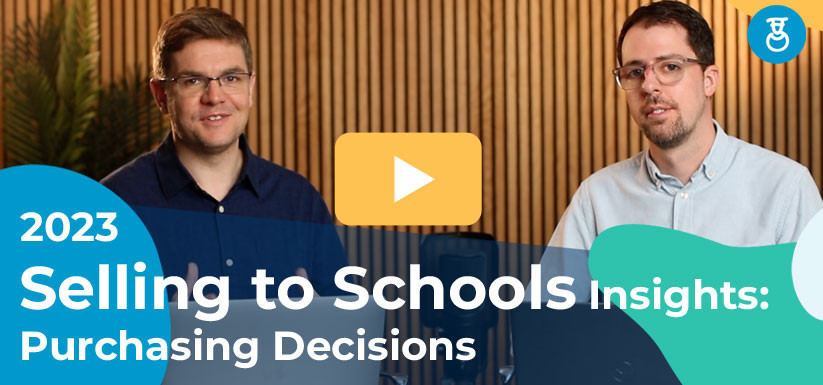

Everything You Need to Know About School Spending
Gain education insights from our State of Selling to Schools Report, about how schools make their purchasing decisions, when they buy, and who makes the decisions.
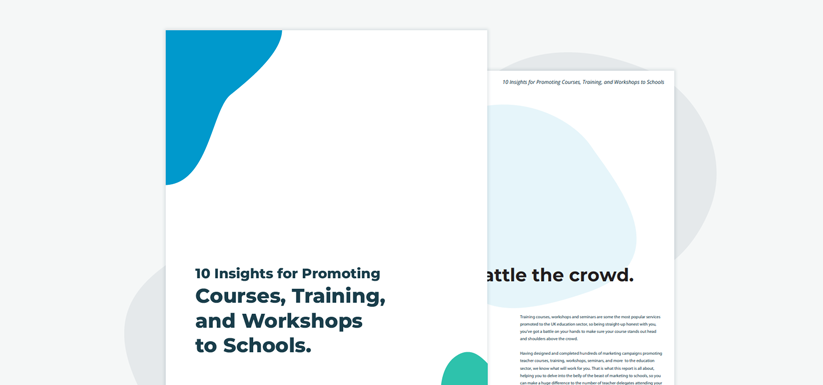

Marketing Courses, Training, and Workshops to Schools
Learn 10 game-changing insights especially for pupil course, training and workshop providers to enhance your education marketing campaigns when emailing schools.


Expert marketing to schools support and solutions
Expert marketing to schools solutions
Email Head Teachers, Teachers, and Staff Inboxes
Email teachers and staff inboxes
Sell More to UK and Global Schools and Colleges
Sell more to schools and colleges

















